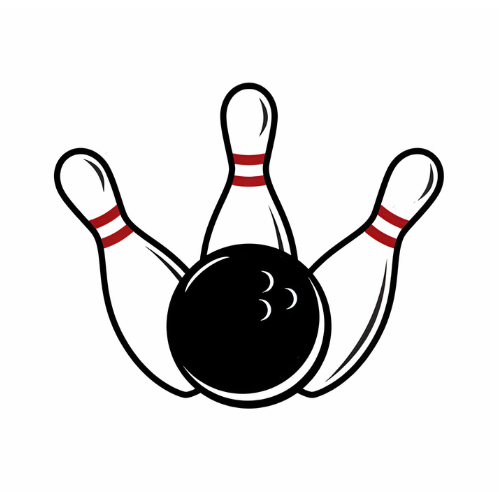It goes without saying that the game of bowling brings smiles to thousands of faces. In fact, the bowling craze has been around for thousands of years. Millions of people now play the game in almost every corner of the world. The exciting part of this game is how the bowler hits the pins by rolling a heavy bowling ball. Here the bowler aims to knock down the pins across the lane with the ball. It wouldn’t be wrong to say that the bowling ball does the key job here. More specifically, the bowling ball can make or break every shot you throw. But ever wondered what’s inside a bowling ball? That’s what I’ll be informing you in this article, Keep reading.

The Origin of Bowling Balls
Bowling is believed to have existed in some form for thousands of years. Even the modern era of bowling has been around for the last hundred years. Interestingly, the concept of bowling was first found in 5200 BC after carving the game in Egyptian royal tombs. The carving shows a man and a woman holding a ball and aiming at 9 uniquely shaped wooden sticks.
This has created great curiosity among anthropologists. In 1930, a British anthropologist discovered some wooden pins in the grave of an Egyptian child buried thousands of years ago. Later on, many anthropologists found wooden objects in various places in Egypt that looked like bowling pins. Since then, the game has been played in ancient Egypt, the Germanic tribes, and the Roman Empire. At that time, the equipment used was not modern as today. Still, the bowler used to make the best out of it. In this modern era, though, the bowling ball has made continuous and significant improvements.
Constructive Evolution
The earlier form of bowling balls and bowling pins were made of a hardwood named Lignum Vitae. They were basically primitive. Those even didn’t have gripping holes. Hence, the bowler used to palm the bowling ball. Moreover, those types of bowling balls were made in different weights and sizes. The bowlers used to play those balls on different lanes. Later, in 1905, the bowling ball was produced from heavy rubber. The famous manufacturing company Brunswick Corporation first bought this type of ball in the market. These balls dominated the industry till the year 1970. Right from this time, the evolution of the modern bowling ball began.
Then in 1980, bowling balls made out of urethane became popular. Urethane-made bowling balls were known as aggressive balls. Then around 1990 came a significant change in bowling ball design. The change is basically the design of the core of the bowling ball. The core was made denser and heavier than the outer layers for overall balance. However, the core can be either spherical, light bulb, or elliptical. Reactive urethane was used in the surface layer in combination with the new core design. These reactive balls have changed the game significantly. Since the 1990s, urethane, polyester, and resin have been used as coverstock materials.
Details of What is Inside a Bowling Ball
The inside of a bowling ball can be divided into three or two stages. The bowling ball has either a three-piece or two-piece construction from the inner core to the outer layer. The three-piece construction comprises a thin coverstock, pancake weight block (core), and filler material. Conversely, the two-piece construction has a thick coverstock and dense weight block (core).
Types of Coverstocks Used in the Bowling Ball
When a bowling ball is thrown, friction happens between the ball and the lane. The nature of the friction depends on the type of coverstock used. The more friction, the more hook potential there is.
Usually, the modern types of bowling balls use four types of coverstock such as;
- Plastic: It considerably reduces friction and also reduces hook potential. Best for beginners because it fits their hands properly.
- Urethane: It has more hook potential than plastic ones. Hence, it creates increased friction and ensures the ball doesn’t bounce. It makes a good pin action.
- Reactive resin: It provides incredible hook potential, friction, and pin action. But, they are difficult to control. Balls made from this type of coverstock are best for experts and professionals.
- Particle: It tends to produce high friction and is hence suitable for experts and all advanced players.
Types of Core Used in the Bowling Ball
Bowling balls may look round from the outside but not from the inside. There is a core that comes in different sizes and shapes. However, the core is made by combining heavy substances like graphite, bismuth, or barium with ceramic or resin.
This combination makes the core even denser. The cores are classified into three types depending on their different sizes and shapes.
- Pancake cores: This type of core exactly looks like a pancake. It is mainly found in reactive resin and urethane balls. However, this type of core balances the entire mass that is lost while the hole is drilled.
- Symmetrical cores: This type of core provides excellent hook potential. Hence, it allows for more finger-hole constructions.
- Asymmetrical cores: This type can be semi-circle or cylindrical. It provides high friction and hence provides a smooth motion.
Final Words
It must be admitted that the inside of a bowling ball is somewhat complex. However, the designers have used different materials and structural patterns since its evolution. So, you can get the best form of a bowling ball for your next classy game. Combining a hard surface and a dense core can make a great bowling ball.
